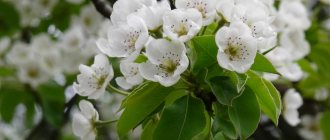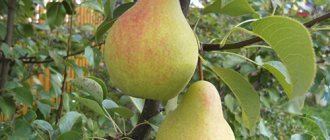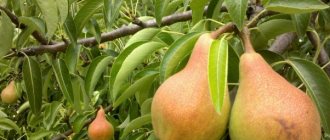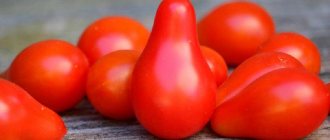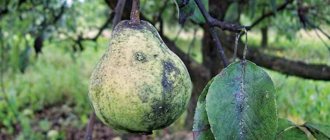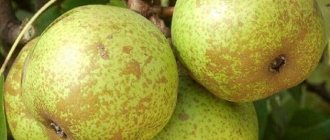Variety differences
Bergamot includes a whole group of varieties that have one characteristic feature - flattened fruits.
Bergamot gained immense popularity among gardeners back in Soviet times, and different varieties of trees of this variety were grown depending on the territory. For example, Red Bergamot, due to its excellent adaptability to temperature changes, was grown mainly in the central regions of the country. In the south and southwest of the USSR, such species as Autumn Bergamot and Maslinovka were popular, but in the western regions Polish Bergamot took root well. The Polish variety of Bergamot has not taken root in other parts of the country because it tolerates long-term transportation worse than others.
The variety got its name from its place of origin - for the first time such a pear was obtained through selection in the city of Bergamo. This variety is popular not only in Russia, it is grown in all European countries and in China. Bergamot has taken root best in warm coastal European countries: in Italy and Spain, as well as in the south of France.
Frost-resistant varieties of Bergamot are most widespread in Russia, while more heat-loving varieties are cultivated in European countries with milder climates. The harvest is harvested in the fall; if storage standards are observed, the pears will be fresh for 2 months.
Pears of this variety bear fruit every year, and the yield is quite high. The fruits, in addition to their unique flattened shape, are small in size and also have a high content of useful substances - arbutin and chlorogenic acid. Such pears are useful for people predisposed to diseases of the genitourinary system, liver and gall bladder. Arbutin and chlorogenic acid promote the rapid removal of salts, waste and toxins from the body.
Important: Bergamot does not tolerate dry soil, it needs a large amount of moisture, so these pears require more abundant watering, unlike other varieties.
Bergamot Moscow
The main distinctive features of the Bergamot Moscow pear variety:
- Trees of this variety have a neat compact crown with an average volume of foliage.
- In terms of height, this type of pear is classified as a medium-sized tree.
- Shoots can have different colors - from light shades of brown to rich brown.
- The shape of the leaves is oval with jagged edges.
- Flowering is long lasting.
- The shape of the fruit is ribbed, the weight reaches 150 g.
- The color of the fruit is green with a yellowish tint and a red blush.
- The fruit pulp is juicy and dense.
- The taste is sweet with sourness.
This pear variety begins to bear fruit at the age of 4 years, and the harvest begins in early autumn - at the very beginning of September. One tree can produce up to 20 kg of fruit per season.
The fruits set well on their own, but if you want to increase the yield of the trees, additional pollination with other pears, such as Marble or Cosmic, will be required.
If we talk about disadvantages, this applies to fruits - they do not last long, and in drought they become sour and astringent.
Advantages and disadvantages
In general, each variety has certain pros and cons - often completely opposite. If we take average indicators, then the advantages include:
- good yield,
- ease of care,
- resistance to drought,
- excellent taste.
Unfortunately, the variety is not without some drawbacks. For example, some varieties have short shelf life.
Note! Also, the variety often suffers from scab, to which it has practically no immunity. This article comes to an end
Having studied it, every gardener can easily decide whether the Bergamot pear is suitable for growing on his plot or whether it is better to choose another option
This concludes the article. Having studied it, every gardener can easily decide whether the Bergamot pear is suitable for growing on his site or whether it is better to choose another option.
Autumn Bergamot
The most popular variety among Russian gardeners. Main characteristics:
- The size of the tree is average.
- The crown has an unusual shape - reverse pyramidal.
- The color of the shoots is soft green, the shoots themselves are quite thick.
- The shape of the leaves is oblong and pointed, the edges are smooth and without jagged edges.
- Frost resistance.
- The tree begins to bear fruit quite late - after 7 years.
- The fruit size is average - no more than 80 g.
- Pears are dark green in color with a clearly visible brick red or burgundy blush.
- The pulp of the fruit is light and quite loose.
- The taste is sweet, and the fruits themselves smell pleasant.
- Autumn Bergamot is a self-fertile variety, but pollination with other types of pears can also be used.
However, despite many advantages, the Bergamot Autumn pear variety has several very noticeable disadvantages. Firstly, trees are very vulnerable to any diseases, but the real scourge for Autumn Bergamot is scab. Due to susceptibility to numerous diseases, the fruitfulness of trees is very low. The harvest is harvested in September, but ripe fruits are stored for a very short time - 3 weeks.
The territories where this variety is most widespread: Russia, Lithuania and Latvia.
Landing
Tomato or ampel tomato - varieties, description and characteristics
Not to be confused with citrus bergamot
First of all, a hole is dug - about 50-55 cm deep and at least 80 cm in diameter. It is filled with a suitable substrate - peat, humus and ash are usually mixed. On poor soils you can also add a little superphosphate.
The seedling is lowered into the prepared hole - it is important to carefully straighten the roots. After this, the roots are sprinkled with earth, which is compacted a little. All that remains is to dig a peg nearby so that the pear grows evenly and does not tilt from the strong wind.
Bergamot Nutmeg
It is not known for certain how and where this variety was bred. Most often, this type of pear can be found in old orchards. Here are the main features of the variety:
- The trees are tall, capable of reaching 8 m in height. The branches are spreading - the crown diameter is large and reaches 12 m.
- The shape of the crown is spherical, the branches are thick.
- The leaf shape is elongated with jagged edges, the size is medium.
- Flowering time is early, flowers reach medium sizes.
- The yield of the variety is high, and the tree itself is capable of bearing fruit even at 60 years of age.
- The fruits are quite large, their average weight is 100 g.
- The color of the pear is green with a yellow tint, the blush is not bright.
- Fruitfulness is very high - in one harvest season you can collect 300 kg of fruit from one tree, and in a lean year - 50 kg.
- The color of the pulp is cream, the fruits are juicy.
- Start harvesting as early as August.
Bergamot Muscat is highly resistant to frost. Even at very low temperatures there were no signs of freezing. The variety is resistant to most diseases, but the fruits themselves attract a large number of wasps. Insects literally eat them, eating away large areas.
Preparing pears for wintering
Preparatory work usually begins with cleaning the area around the tree. Fallen leaves and carrion from branches are collected, and dried fruits are removed. Old mulch is also removed. It is advisable to burn all this garbage.
Dried and diseased branches are removed from the tree. The entire crown and trunk are sprayed from scab. You can use a 5% urea solution for this. Growths are also removed from the trunk.
Important! If wounds appear on the Bergamot pear in the summer, they are cleaned to healthy tissue, then washed with a solution of copper sulfate and covered with garden varnish. To protect the Bergamot trunk from rodents (hares, mice), the tree is wrapped with protective material
For these purposes, ordinary burlap and spruce wood are suitable
To protect the Bergamot trunk from rodents (hares, mice), the tree is wrapped with protective material. For these purposes, ordinary burlap and spruce wood are suitable.
Bergamot in memory of Prince Trubetskoy
This variety was bred in the Trubetskoy garden. It is distinguished by several characteristics:
- The size of the trees is medium, the branches are thin, the crown is quite dense.
- The leaf shape is oblong, the color is bright green.
- Trees are famous for their longevity; they grow for decades.
- Fruiting begins at 4 years of age.
- The plant is unpretentious to weather conditions and soil.
- High frost resistance.
- The fruits are large, reaching an average of 190 g.
- Harvest from September to early October.
- The fruit is yellow with a bright blush, located on the sunny side.
- The taste is sweet.
- The pulp is very juicy and soft.
This variety of fruit trees is resistant to various diseases, especially fungal ones. The harvested crop is well stored for about two months.
Diseases and pests
The most common diseases are powdery mildew and scab. The first can be combated by spraying the leaves with a solution of colloidal sulfur. The scab problem can be solved with the help of Bordeaux mixture, as well as a weak urea solution. Both the tree itself and the soil under the entire crown area are treated.
The most common pest is aphids. The problem can be solved by applying suitable insecticides. The main thing is to do this in a timely manner and at least a few days before the formation of fruits.
Scab must be dealt with harshly
How to care for Bergamot pear
In order for pears to feel good, you need to determine the right place for them on the site. Bergamot loves well-ventilated hills. Suitable soil is chernozem or loam.
An important condition: the soil must be as fertile as possible, so tired soils are not suitable for growing young trees.
Mature Bergamot pears require periodic feeding with organic substances - manure and urea. Trees also need a lot of sunlight, but seedlings need shade during hot weather.
Watering trees should be plentiful, especially during the dry summer period. You will also need to increase the amount of water for irrigation during fruit ripening.
Bergamot seedlings are best planted in a so-called chatterbox, since their roots are quite weak. Depending on the condition of the root system after planting, you need to cut off the top of the tree by 1/3 or even 1⁄2 of the total growth.
The planting hole should be dug 0.7 m deep and 1 m in diameter. In the first two years, the young tree will adapt to the new environment, so during this period it needs a lot of water. The branches and trunk grow quite slowly.
If you plan to graft a pear, then you need to follow several rules. Despite the fact that it is easier to purchase seedlings than to plant cuttings at home, some people use this particular method of propagating pears. So here are the basic rules:
- A healthy branch to which the cuttings will be grafted should be located above a box filled with fertile soil.
- The branch is bent into the box for further digging, and in the places where it will be buried, you need to cut the bark in the transverse direction.
- The next step is to sprinkle the branch with soil and strengthen it.
- To make the roots begin to grow faster, you can add special preparations to the water for irrigation that accelerate growth.
- To prevent the branch and young roots from drying out, the soil must be mulched periodically.
Tree care
During the first time after planting, it is important to provide young trees with regular watering. At least twice a week, up to 10 liters of water should be poured under each Bergamot pear seedling. Then, if possible, loosen the soil and remove weeds.
In addition to watering, caring for pear trees involves fertilizing, carrying out preventive measures aimed at preventing the appearance of diseases and pests, as well as providing protection from the cold.
To obtain a good harvest, both mineral and organic fertilizers should be applied. Nutrient solutions of mineral substances can be used for foliar feeding by spraying the tree crowns. Organic fertilizers are applied in various ways. So, for example, you can prepare an infusion and fertilize along with watering the trees, or add organic matter directly to the soil around the tree trunk, adding compost or humus while digging the soil.
Organic fertilizers are recommended to be applied in the autumn, and in the spring the tree is more in need of nitrogen-containing substances that promote the active growth of green mass.
Prevention of the occurrence of diseases and pests is, first of all, keeping the tree trunk clean. After all, as you know, many pathogens, as well as insect pests, often settle in fallen leaves and weeds.
Trees of the Bergamot pear variety, as noted above, are distinguished by good frost resistance. Therefore, their protection from frost is more important during the flowering period of the tree than in winter. Exceptions, perhaps, are young trees that have just been planted, as well as cases of growing pears in regions with very cold winters.
In order for the tree to overwinter without loss, the tree trunk circle is mulched with a layer at least 8-10 cm thick. Additionally, the tree trunk can be covered with spruce branches, and, as precipitation falls, snow can also be shoveled towards the tree trunk. Some gardeners use thermal insulation materials for these purposes, wrapping them around a tree trunk. Young trees can be completely covered using special material.
Pruning rules
An integral part of caring for Bergamot pear trees is their pruning. More often, sanitary and anti-aging pruning is carried out. The need for formative pruning arises much less frequently, since the crown of pear trees is formed naturally.
Sanitary pruning is usually carried out twice - in spring and autumn. This type of pruning involves the removal of dry and broken branches, as well as those that have been affected by various diseases or pests. In addition, sometimes so-called tops form on frozen shoots. The reason for their appearance, by the way, may be an excessive amount of nitrogen-containing fertilizers applied, or too much watering of the tree. It is also recommended to remove the emerging tops, since these shoots help slow down the growth of skeletal branches.
Anti-aging pruning of Bergamot pear is aimed at stimulating the growth of new fruit-bearing shoots. To begin with, cut off the central conductor. From the point where the skeletal branches are located at large intervals, they retreat up the trunk 3.5 meters and cut off the top. Next, several skeletal branches located in the upper part of the new crown are removed. Next year you can shorten several skeletal and semi-skeletal branches. After pruning, the length of the shoots should be no more than 1 meter.
There is no need to be overzealous with pruning; it is better to do it gradually and in a gentle manner.
Uses of Bergamot pear fruit
Pear contains many vitamins and beneficial microelements. The fruits also contain folic acid and essential oils. The fruits can be eaten raw or cooked from them.
Most often, pears are prepared for the winter in the form of jam and compotes. However, not only fruits are actively used. Thus, pear bark is used to dye fabrics, and the wood is used to make furniture and various wood products.
Pear has different properties depending on the type chosen. Choose a variety depending on your own wishes and conditions in the garden.
